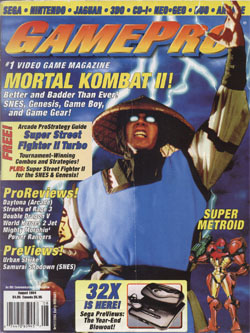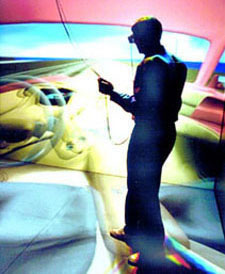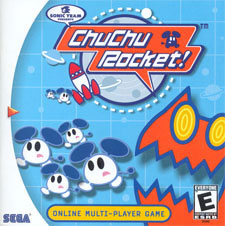- CLASSIC MAGAZINES
- REVIEW CREW
A show recapping what critics thought back
when classic games first came out! - NEXT GENERATION'S BEST & WORST
From the worst 1-star reviews to the best
5-stars can offer, this is Next Generation! - NINTENDO POWER (ARCHIVE)
Experience a variety of shows looking at the
often baffling history of Nintendo Power! - MAGAZINE RETROSPECTIVE
We're looking at the absolutely true history of
some of the most iconic game magazines ever! - SUPER PLAY'S TOP 600
The longest and most ambitious Super NES
countdown on the internet! - THEY SAID WHAT?
Debunking predictions and gossip found
in classic video game magazines! - NEXT GENERATION UNCOVERED
Cyril is back in this spin-off series, featuring the
cover critic review the art of Next Generation! - HARDCORE GAMER MAGAZING (PDF ISSUES)
Download all 36 issues of Hardcore Gamer
Magazine and relive the fun in PDF form!
- REVIEW CREW
- ELECTRONIC GAMING MONTHLY
- ELECTRONIC GAMING MONTHLY RANKS
From Mario to Sonic to Street Fighter, EGM
ranks classic game franchises and consoles! - ELECTRONIC GAMING MONTHLY BEST & WORST
Counting down EGM’s best and worst reviews
going year by year, from 1989 – 2009! - ELECTRONIC GAMING BEST & WORST AWARDS
11-part video series chronicling the ups and
downs of EGM’s Best & Worst Awards!
- ELECTRONIC GAMING MONTHLY RANKS
- GAME HISTORY
- GAME OVER: STORY BREAKDOWNS
Long-running series breaking down game
stories and analyzing their endings! - A BRIEF HISTORY OF GAMING w/ [NAME HERE]
Real history presented in a fun and pithy
format from a variety of game historians! - THE BLACK SHEEP
A series looking back at the black sheep
entries in popular game franchises! - INSTANT EXPERT
Everything you could possibly want to know
about a wide variety of gaming topics! - FREEZE FRAME
When something familiar happens in the games
industry, we're there to take a picture! - I'VE GOT YOUR NUMBER
Learn real video game history through a series
of number-themed episodes, starting at zero! - GREAT MOMENTS IN BAD ACTING
A joyous celebration of some of gaming's
absolute worst voice acting!
- GAME OVER: STORY BREAKDOWNS
- POPULAR SHOWS
- DG NEWS w/ LORNE RISELEY
Newsman Lorne Riseley hosts a regular
series looking at the hottest gaming news! - REVIEW REWIND
Cyril replays a game he reviewed 10+ years
ago to see if he got it right or wrong! - ON-RUNNING FEUDS
Defunct Games' longest-running show, with
editorials, observations and other fun oddities! - DEFUNCT GAMES QUIZ (ARCHIVE)
From online quizzes to game shows, we're
putting your video game knowledge to the test!- QUIZ: ONLINE PASS
Take a weekly quiz to see how well you know
the news and current gaming events! - QUIZ: KNOW THE GAME
One-on-one quiz show where contestants
find out if they actually know classic games! - QUIZ: THE LEADERBOARD
Can you guess the game based on the classic
review? Find out with The Leaderboard!
- QUIZ: ONLINE PASS
- DEFUNCT GAMES VS.
Cyril and the Defunct Games staff isn't afraid
to choose their favorite games and more! - CYRIL READS WORLDS OF POWER
Defunct Games recreates classic game
novelizations through the audio book format!
- DG NEWS w/ LORNE RISELEY
- COMEDY
- GAME EXPECTANCY
How long will your favorite hero live? We crunch
the numbers in this series about dying! - VIDEO GAME ADVICE
Famous game characters answer real personal
advice questions with a humorous slant! - FAKE GAMES: GUERILLA SCRAPBOOK
A long-running series about fake games and
the people who love them (covers included)! - WORST GAME EVER
A contest that attempts to create the worst
video game ever made, complete with covers! - LEVEL 1 STORIES
Literature based on the first stages of some
of your favorite classic video games! - THE COVER CRITIC
One of Defunct Games' earliest shows, Cover
Critic digs up some of the worst box art ever! - COMMERCIAL BREAK
Take a trip through some of the best and
worst video game advertisements of all time! - COMIC BOOK MODS
You've never seen comics like this before.
A curious mix of rewritten video game comics!
- GAME EXPECTANCY
- SERIES ARCHIVE
- NINTENDO SWITCH ONLINE ARCHIVE
A regularly-updated list of every Nintendo
Switch Online release, plus links to review! - PLAYSTATION PLUS CLASSIC ARCHIVE
A comprehensive list of every PlayStation
Plus classic release, including links! - RETRO-BIT PUBLISHING ARCHIVE
A regularly-updated list of every Retro-Bit
game released! - REVIEW MARATHONS w/ ADAM WALLACE
Join critic Adam Wallace as he takes us on a
classic review marathon with different themes!- DEFUNCT GAMES GOLF CLUB
Adam Wallace takes to the links to slice his way
through 72 classic golf game reviews! - 007 IN PIXELS
Adam Wallace takes on the world's greatest spy
as he reviews 15 weeks of James Bond games! - A SALUTE TO VAMPIRES
Adam Wallace is sinking his teeth into a series
covering Castlevania, BloodRayne and more! - CAPCOM'S CURSE
Adam Wallace is celebrating 13 days of Halloween
with a line-up of Capcom's scariest games! - THE FALL OF SUPERMAN
Adam Wallace is a man of steel for playing
some of the absolute worst Superman games! - THE 31 GAMES OF HALLOWEEN
Adam Wallace spends every day of October afraid
as he reviews some of the scariest games ever! - 12 WEEKS OF STAR TREK
Adam Wallace boldly goes where no critic has
gone before in this Star Trek marathon!
- DEFUNCT GAMES GOLF CLUB
- DAYS OF CHRISTMAS (ARCHIVE)
Annual holiday series with themed-episodes
that date all the way back to 2001!- 2015: 30 Ridiculous Retro Rumors
- 2014: 29 Magazines of Christmas
- 2013: 29 Questionable Power-Ups of Christmas
- 2012: 34 Theme Songs of Christmas
- 2011: 32 Game Endings of Christmas
- 2010: 31 Bonus Levels of Christmas
- 2009: 30 Genres of Christmas
- 2008: 29 Controls of Christmas
- 2007: 34 Cliches of Christmas
- 2006: 33 Consoles of Christmas
- 2005: 32 Articles of Christmas
- 2004: 31 Websites of Christmas
- 2003: 29 Issues of Christmas
- 2002: 28 Years of Christmas
- 2001: 33 Days of Christmas
- NINTENDO SWITCH ONLINE ARCHIVE
- REVIEW ARCHIVE
- FULL ARCHIVE
In the Future: GamePro Predicts 1999

August 1994: Introducing the Mortal Kombat Opera!
So you can imagine my giddiness when I opened up the August 1994 issue of GamePro and discovered their predictions for the year 1999. I was all ready to spend two thousand words ripping into my favorite punching bag. But a funny thing happened as I read through their rather conservative predictions. I thought that they might shoot for the stars and predict things that could never come true, but that's not what they did. Instead they chose eight realistic predictions that mostly came true. For once in their life, GamePro got it right.
And then it dawned on me, they are getting so many of these predictions right because they aren't predictions at all. Instead of talking about 256-bit consoles and amazing holographic technology, the editors of GamePro predicted things that had already been announced. I'm talking about predicting the PlayStation and Nintendo 64, a safe bet in 1994. Even with these relatively safe predictions, I found their article to be an interesting look into the mind of GamePro. See for yourself as we delve deep into their predictions and uncover the reality.
Quote 1: In the Future Everybody Loves Games!
"The electronic entertainment industry will be bigger and better than ever, probably doubling in size compared to today."
Reality:
No question about it, the video game industry definitely got bigger and better. Thanks to the Sony PlayStation, a new breed of older gamers we started to see more mature games and less kid-friendly mascot

It's official: Dreamcast more popular than Star Wars Episode I!
characters. All this led to the 1999 launch of the Sega Dreamcast, one of the most successful hardware launches of all time. Sega trumpeted that their system's launch out grossed the biggest movie of that year, Star Wars Episode I: The Phantom Menace. By 1999 it was clear that video games were here to stay.
But it wasn't until one year later that video games truly went mainstream. Thanks to DVD technology, consoles like the PlayStation 2 and Microsoft Xbox forever changed the landscape of the gaming industry. Since then the games industry has more than doubled where it was in 1994, it's become much bigger than anybody could have predicted. It used to be that a console like the Sega Genesis or Super NES could only hope to sell a few hundred thousand units in a year, while even the worst selling consoles these days are selling in the millions. The PlayStation 2 alone has close to 140 million units sold, while the Genesis has just over 30 million worldwide. The Nintendo DS is on track to do even better than the PlayStation 2, so this industry has blown up in bigger and better ways than GamePro had hoped.

It's official: Dreamcast more popular than Star Wars Episode I!
But it wasn't until one year later that video games truly went mainstream. Thanks to DVD technology, consoles like the PlayStation 2 and Microsoft Xbox forever changed the landscape of the gaming industry. Since then the games industry has more than doubled where it was in 1994, it's become much bigger than anybody could have predicted. It used to be that a console like the Sega Genesis or Super NES could only hope to sell a few hundred thousand units in a year, while even the worst selling consoles these days are selling in the millions. The PlayStation 2 alone has close to 140 million units sold, while the Genesis has just over 30 million worldwide. The Nintendo DS is on track to do even better than the PlayStation 2, so this industry has blown up in bigger and better ways than GamePro had hoped.
Quote 2: In the Future Games Look like TV Shows!
"The dream of the 80s will come true in the 90s as the technological limits that have held back hardware and software designers are overcome during the next several years. Say hello to 32-bit, 64-bit, and higher-bit systems with standard features like 3D capability, full-motion video, 16-million colors, graphics co-processor, voice recognition and more."
Reality:
Okay, so it doesn't take much to predict that the video games of the near future would have 3D graphics, 64-bit technology and full-motion video. After all, these were the

Maybe if this girl would stop posing for the camera she would recognize what I was telling her to do!
things that video game companies were toying with back when these predictions were made. But I'll give them the benefit of the doubt and take these advancements one at a time.
GamePro was definitely right about saying hello to 32-bit (the Sega Saturn and PlayStation, both of which had been announced by the time of this editorial), 64-bit (the Jaguar was out and the Nintendo 64 had been long-rumored) and higher-bit systems (the Sega Dreamcast). By 1999 the idea of 3D gaming was a reality; most of the types of 3D games we play today were born out of the experiments found on both the Dreamcast and Nintendo 64. While it's true that game companies have mastered full-motion video, these days it's used sparingly and rarely with the actual gameplay. Needless to say, you didn't see a lot of Night Trap-inspired games in 1999. 16 million colors is indeed the industry standard, something introduced with the Dreamcast. There are indeed graphics co-processors, something that computers were playing with in the mid 1990s. And finally, by 1999 companies knew how to use voice recognition ... they just didn't use it. Outside of a few SOCOM titles, Konami's Life Line and Tom Clancy's End War, there really aren't that many games that take advantage of voice recognition.

Maybe if this girl would stop posing for the camera she would recognize what I was telling her to do!
GamePro was definitely right about saying hello to 32-bit (the Sega Saturn and PlayStation, both of which had been announced by the time of this editorial), 64-bit (the Jaguar was out and the Nintendo 64 had been long-rumored) and higher-bit systems (the Sega Dreamcast). By 1999 the idea of 3D gaming was a reality; most of the types of 3D games we play today were born out of the experiments found on both the Dreamcast and Nintendo 64. While it's true that game companies have mastered full-motion video, these days it's used sparingly and rarely with the actual gameplay. Needless to say, you didn't see a lot of Night Trap-inspired games in 1999. 16 million colors is indeed the industry standard, something introduced with the Dreamcast. There are indeed graphics co-processors, something that computers were playing with in the mid 1990s. And finally, by 1999 companies knew how to use voice recognition ... they just didn't use it. Outside of a few SOCOM titles, Konami's Life Line and Tom Clancy's End War, there really aren't that many games that take advantage of voice recognition.
Quote 3: In the Future You Can Download Games!
"CD-based systems and on-line distribution (like the Sega Channel) will win out as the predominant game-delivery system of the near future. But don't expect retailers like Toys "R" Us and Blockbuster to close their doors -- they'll be stronger than ever."
Reality:
Think the drum beat for digital distribution is brand new? Here's GamePro talking downloadable titles in 1994. Thanks to online computer games and the Sega Channel, it definitely looked like the future was going

Sure it's sleek and sexy, but it's also expensive and doesn't play UMDs!
to be games on demand. However, that certainly didn't happen by 1999. Outside of third party peripherals and Sega's failed attempt at taking the Saturn online, the 1990s didn't see much of a push towards online gaming. In fact, it wasn't until 2000 that the Dreamcast went online, and even then it didn't support downloadable games.
Fast forward fifteen years and you have the release of the Sony PSPgo, the console market's first console to only allow digital distribution. Even though the PlayStation 3, Xbox 360 and Wii have all offered downloadable titles, nobody is going to say that this method is the "predominant game-delivery system." In the next few years we may see more of an emphasis placed on digital distribution, but that's not going to happen without a fight from game retailers. Whether Toys "R" Us and Blockbuster will be "stronger than ever" is yet to be seen, but I can tell you right now that GameStop isn't going to take this affront lying down.

Sure it's sleek and sexy, but it's also expensive and doesn't play UMDs!
Fast forward fifteen years and you have the release of the Sony PSPgo, the console market's first console to only allow digital distribution. Even though the PlayStation 3, Xbox 360 and Wii have all offered downloadable titles, nobody is going to say that this method is the "predominant game-delivery system." In the next few years we may see more of an emphasis placed on digital distribution, but that's not going to happen without a fight from game retailers. Whether Toys "R" Us and Blockbuster will be "stronger than ever" is yet to be seen, but I can tell you right now that GameStop isn't going to take this affront lying down.
Quote 4: In the Future Hollywood Will Merge!
"Look for a merging of the different entertainment businesses: Music, games, and, of course, Hollywood."

Not even GamePro could have predicted the success of fake plastic guitars!
Reality:
How is it a prediction when these things were already happening? By 1994 we had already suffered through several terrible video game movies (Super Mario Bros., Double Dragon and Street Fighter) and played way too many crummy movie adaptations. Real actors were even starting to find their way into games; although they were mostly out of work D-list actors like Dana Plato (Night Trap) and Corey Haim (Double Switch). And while it would take the music industry a lot longer to catch up, you could still find popular tunes in games like Rock 'n Roll Racing and the Make My Video series.
Of course, by 1999 all of these industries were tightly linked. Hollywood would often use game technology in movies (Hackers is a good example of this) and there were plenty of bands that sang about playing games (Eiffel 65 springs to mind). These days the lines are so blurry that it's often hard to see where gaming starts and Hollywood ends. A game like Rock Band or Guitar Hero might as well be an extension of the recording industry. In fact, some music producers are looking to gaming as a way to reverse their downward trend. It's clear that GamePro got this one right. My only issue is that all of the way happening before 1994, so how can this be a prediction?
Of course, by 1999 all of these industries were tightly linked. Hollywood would often use game technology in movies (Hackers is a good example of this) and there were plenty of bands that sang about playing games (Eiffel 65 springs to mind). These days the lines are so blurry that it's often hard to see where gaming starts and Hollywood ends. A game like Rock Band or Guitar Hero might as well be an extension of the recording industry. In fact, some music producers are looking to gaming as a way to reverse their downward trend. It's clear that GamePro got this one right. My only issue is that all of the way happening before 1994, so how can this be a prediction?
Quote 5: In the Future Gameplay Will Be Futuristic!
"Game play itself will evolve, becoming more experimental, more personalized, more interpersonal, more challenging, more interactive and ... well ... more, more, more!"
Reality:
As we go through these predictions it's important to remember that GamePro was talking about the year 1999, not our current 2009. I bring this up because in the last 15 years gameplay has indeed evolved. These days you have the touch screen support of

16 years after GamePro predicted evolved gameplay, Sony will introduce a control with a ball on the end!
the Nintendo DS and the Wii's motion controls. And let's not forget about the Sony EyeToy, all of the fake plastic instruments, the upcoming Natal and the motion control that Sony is promising. In other words, by 2009 gameplay has evolved into something almost unrecognizable to those Super NES users of 1994.
But this prediction isn't about 2009 ... it's about 1999. By 1999 gameplay really hadn't changed that much. Sure there was the rumble pack and everybody used at least one analog stick, but we had seen companies toy with these type of advancements before 1994. I'm sure that Dreamcast owners would argue that many games became more experimental and thanks to online gameplay everything became a little more interpersonal. The invent of 3D polygons and realistic physics also aided in making games more interactive. But GamePro was wrong about one thing, video games of 1999 were not more challenging. Thanks to checkpoints and unlimited continues, modern games have become significantly easier. Even the hardest game of 1999 is a cake walk when compared to the original Contra or Ninja Gaiden.

16 years after GamePro predicted evolved gameplay, Sony will introduce a control with a ball on the end!
But this prediction isn't about 2009 ... it's about 1999. By 1999 gameplay really hadn't changed that much. Sure there was the rumble pack and everybody used at least one analog stick, but we had seen companies toy with these type of advancements before 1994. I'm sure that Dreamcast owners would argue that many games became more experimental and thanks to online gameplay everything became a little more interpersonal. The invent of 3D polygons and realistic physics also aided in making games more interactive. But GamePro was wrong about one thing, video games of 1999 were not more challenging. Thanks to checkpoints and unlimited continues, modern games have become significantly easier. Even the hardest game of 1999 is a cake walk when compared to the original Contra or Ninja Gaiden.
Quote 6: In the Future People Will Like VR
"Virtual reality will be more of a reality and less of a fantasy, making for more realistic gameplay experiences."

Like this ... only with fewer mind altering drugs in your system!
Reality:
In the early 1990s, Virtual Reality was the next step in video game realism. You saw it in movies like The Lawnmower Man and touted in magazines as the obvious next step. Heck, even Sega and Atari had their own proposed (although never released) VR headsets, and Nintendo went one step further and released a faux-virtual reality "portable" called the Virtual Boy. It was clear that everybody was virtual reality crazy in 1994.
However, by 1999 nobody seemed to care about the promise of virtual reality. Instead we had online first-person shooters on the computer and realistic 3D graphics on the Dreamcast. Who wants to put a bulky headset on when you could get the same rush out of playing Quake III or Half-Life? Here we are fifteen years after this prediction and I bet you can't even remember the last time you thought about virtual reality. It's a complete non-issue, thanks in large part to motion controls that are fulfilling the promise of a "more realistic gameplay experience."
However, by 1999 nobody seemed to care about the promise of virtual reality. Instead we had online first-person shooters on the computer and realistic 3D graphics on the Dreamcast. Who wants to put a bulky headset on when you could get the same rush out of playing Quake III or Half-Life? Here we are fifteen years after this prediction and I bet you can't even remember the last time you thought about virtual reality. It's a complete non-issue, thanks in large part to motion controls that are fulfilling the promise of a "more realistic gameplay experience."
Quote 7: In the Future Online Gaming Will Explode!
"Expect more multiplayer gaming, especially with the predicted explosion of online services."
Reality:
Here's an example of GamePro missing the prediction by only a couple of years. While computer gamers enjoyed

While it wasn't much of an explosion, Chu Chu Rocket was a lot of fun online!
playing Doom and other shooters online in the mid-1990s, it took the console makers a few years to catch up. The Dreamcast, for example, didn't offer online gaming until the year 2000. But while the Dreamcast dabbled in the online marketplace, it wasn't until Microsoft (and Sony, to a much less extent) introduced their Xbox Live that the idea of online gameplay really exploded.
To GamePro's credit, there were a number of companies that attempted to bring online gaming to the home consoles. In the 16-bit era you had the X-Band, a device that allowed both Super NES and Genesis owners to play against people online. In 1995 Atari had planned on releasing a Jaguar modem. And of course Sega had their NetLink, a low-selling add-on to the Sega Saturn. In this regard GamePro is correct, there certainly was more muliplayer gaming and online services, they just didn't catch on until the start of the 21st century.

While it wasn't much of an explosion, Chu Chu Rocket was a lot of fun online!
To GamePro's credit, there were a number of companies that attempted to bring online gaming to the home consoles. In the 16-bit era you had the X-Band, a device that allowed both Super NES and Genesis owners to play against people online. In 1995 Atari had planned on releasing a Jaguar modem. And of course Sega had their NetLink, a low-selling add-on to the Sega Saturn. In this regard GamePro is correct, there certainly was more muliplayer gaming and online services, they just didn't catch on until the start of the 21st century.
Quote 8: In the Future Girls Will Like Games!
"Although the biggest game players will continue to be teenage guys, we'll see more and more girls and adults enjoying electronic entertainment than ever before."
Reality:
Thanks to the PlayStation and Sega Saturn, by 1999 the biggest gaming market was in his twenties. Since then that age has continued to rise,

She may not be able to act, but Megan Fox can rock at Guitar Hero III!
thanks in large part to mature games like Grand Theft Auto and Halo. Of course, teenagers are still a large target for game companies, so it's not like the numbers have been completely reversed. However, by 1999 the clear push was for older teens and adults.
Over the past decade women have become a huge market for game companies. Polling shows that there are a significant amount of older women playing MMO games and a lot of younger girls own at least one Nintendo DS. We also see a lot of growth in the casual game market, which is introducing a lot of non-gamers into this wonderful pastime. Say what you will about the Wii's software line-up, but it's clear that Nintendo has done an excellent job of broadening the market, making games a mainstream activity enjoyed by more than just teenage boys. Games are for everybody. GamePro may have been right in their prediction, but I doubt they could have guessed that this industry would become so broad and diverse.

She may not be able to act, but Megan Fox can rock at Guitar Hero III!
Over the past decade women have become a huge market for game companies. Polling shows that there are a significant amount of older women playing MMO games and a lot of younger girls own at least one Nintendo DS. We also see a lot of growth in the casual game market, which is introducing a lot of non-gamers into this wonderful pastime. Say what you will about the Wii's software line-up, but it's clear that Nintendo has done an excellent job of broadening the market, making games a mainstream activity enjoyed by more than just teenage boys. Games are for everybody. GamePro may have been right in their prediction, but I doubt they could have guessed that this industry would become so broad and diverse.
HOME |
CONTACT |
NOW HIRING |
WHAT IS DEFUNCT GAMES? |
NINTENDO SWITCH ONLINE |
RETRO-BIT PUBLISHING
Retro-Bit |
Switch Planet |
The Halcyon Show |
Same Name, Different Game |
Dragnix |
Press the Buttons
Game Zone Online | Hardcore Gamer | The Dreamcast Junkyard | Video Game Blogger
Dr Strife | Games For Lunch | Mondo Cool Cast | Boxed Pixels | Sega CD Universe | Gaming Trend
Game Zone Online | Hardcore Gamer | The Dreamcast Junkyard | Video Game Blogger
Dr Strife | Games For Lunch | Mondo Cool Cast | Boxed Pixels | Sega CD Universe | Gaming Trend
Copyright © 2001-2025 Defunct Games
All rights reserved. All trademarks are properties of their respective owners.
All rights reserved. All trademarks are properties of their respective owners.
























